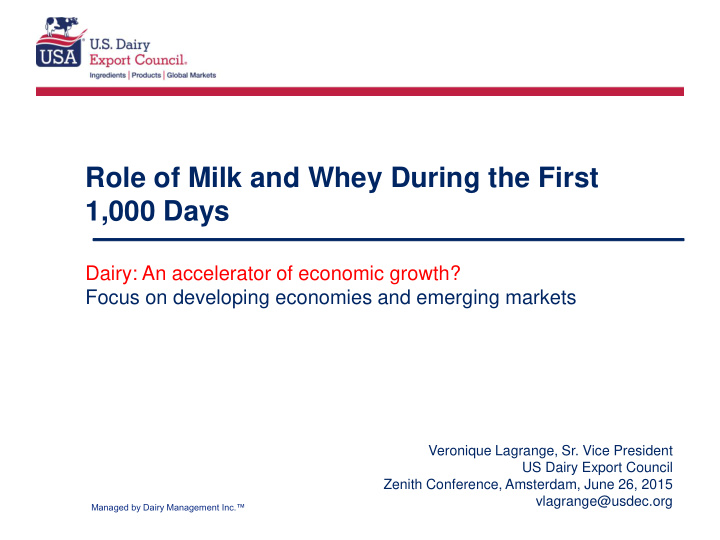



Role of Milk and Whey During the First 1,000 Days Dairy: An accelerator of economic growth? Focus on developing economies and emerging markets Veronique Lagrange, Sr. Vice President US Dairy Export Council Zenith Conference, Amsterdam, June 26, 2015 vlagrange@usdec.org Managed by Dairy Management Inc.™
Agenda • Stunting and its cost to nations • Low birth weight: a new focus • Revisiting protein quality, needs, and nutrition innovation 2 Photo sources: Berkeley.edu, NGOhealth committee, US Dairy Export Council
What is stunting? Moderately Malnourished Children 195 million, 25% of children worldwide affected by Photos: TOP 9-years old raised in stunting Guatemala, BOTTOM same age group, Los Angeles
Prevalence of stunting • 40% of children in sub-Saharan Africa • East and South Asia: 50% of children (estimates) 4 Source, diagram courtesy: UNICEF, 2015
Economic significance Asia and Africa lose 11% of their GDP every year owing to poor nutrition • Lower productivity • Increase risk of chronic disease • Obesity later in life Diagram courtesy: Gates Foundation, 2015
And impact at the individual level • Adults undernourished as children have a lower IQ • They earn at least 20% less than those that were not 6 Source, diagram courtesy: UNICEF, 2015
Economic Rationale for Investing in Nutrition • Demonstrated economic rationale for investing in stunting reduction: • Benefit-cost ratio average: 18* • Fit-for-purpose nutrition , not just food is part of the solution Source: 7 *Hoddinott, J. Maternal & Child Nutrition, 2013 (9) Suppl. 2
Dairy and severe malnutrition: strong evidence of efficacy, part of standard of care To meet UNICEF specifications, RUTF needs to contain: • >20-25% skim milk powder or, • 30% WPC34, or • 60% sweet whey (or a combination of those) 8 Source: UNICEF.org
Moderate malnutrition: milk, whey recommended Treatment of MAM is key to stunting prevention Dairy ingredients are recommended , but not yet standard of care Goal: Deliver dairy evidence, recommended dose to WHO for policy development 9
• Stunting and its cost to nations • Low birth weight: a new focus • Revisiting protein quality, needs, and nutrition innovation 10 Photo sources: Berkeley.edu, NGOhealth committee, US Dairy Export Council
Children’s nutrition is important, mothers’ too • 30% of stunting occurs in- utero • Pregnant mothers have higher nutritional needs: proteins, calcium, vitamins – not just energy 11 Photo courtesy: PBS USA, 2014
Low birth weight: a new United Nations focus United Nations: new targets for pregnant women and their nutrition Graph courtesy: 1,000 Days Foundation 12
Not a new concept… • But in developing countries, she will be pregnant or lactating for 18 years of her life… • Can she afford these products over her lifetime? • Are they even available? 13 Photo sources: Yashili, Fonterra, Abbott, Dumex
Emerging science adds evidence needed by policy makers • Maternal cow’s milk consumption (>3 glasses/day) was associated with greater fetal weight gain in 3 rd trimester • Maternal milk consumption not associated with length growth • Protein intake from other non- dairy sources was not associated with birth weight increases. 14 Source: Heppe et al., 2011
Potential for affordable, effective formula for women • Supplements • Fortification of everyday foods • Need support by Governments, NGOs, and from UN agencies, other donors 15
• Stunting and its cost to nations • Low birth weight: a new focus • Revisiting protein quality, needs, and nutrition innovation 16 Photo sources: Berkeley.edu, NGOhealth committee, US Dairy Export Council
Nutrition innovation in the 21 st century • Revisiting nutritional needs and protein quality 17 Source: FAO, published 2013
New method to measure protein quality: DIAAS 18 Table source: Moughan, 2012
DIAAS correlated with recovery Relationship Between Protein Score and Average Recovery Outcome in Children Treated for SAM with RUTF/F100 Average Recovery Outcome (g/kg/day) Protein Digestibility Score (%) 19 Chart source: Manary, 2014
Cost-effectiveness (MAM) Fortified blended foods, complementary foods Dairy component (LNS) Perceived high cost of Dairy component dairy ingredient a barrier… No dairy Despite evidence on overall cost of treatment (moderate malnutrition) 20 Diagram source: World Food Program, 2014
Possible impact on entire infant formula sector • Allow to deliver formula closer to breast milk (lower protein than dairy) • But with optimized amino- acid balance: more closely match plasma amino acid concentration in the infant 21 Photo courtesy: Food Navigator Asia
The customers and market potential UNICEF Purchases of In 2014, WFP purchased over RUTF (in mt) $75 million worth of 2005 2011 2013 specialized nutritious foods. 34000 MSF, other NGOs and 27000 foundation purchase significant volumes + large future needs Market potential for category could exceed 300,000 mt of 2000 dairy ingredients RUTF Purchases by UNCEF (in mt) 22
Revisiting protein and needs for 21 st century • Stunting: dairy is part of the solution • Dairy ingredients: AA composition and utilization (DIAAS), Type II minerals, lactose support growth, lean body mass accretion • 1,000 days nutrition: need adoption of new WHO policies supported by sound, pre-competitive science • Large market potential in all developing economies for affordable, optimized products with good shelf-life under adverse conditions 23
Thank you! www.dairyforglobalnutriton.org Veronique Lagrange, US Dairy Export Council, USA vlagrange@usdec.org 24
Recommend
More recommend